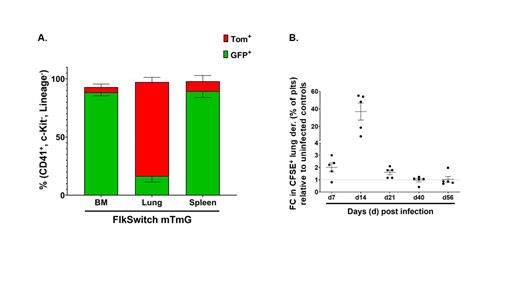Platelet-producing megakaryocytes (Mks) are present in the lung, and we have described an immune modulatory phenotype of lung Mks. It is assumed that the extravascular lung Mks are ‘seeded’ from the bone marrow (BM). To investigate lung Mk origin and how origin may impact function, we used complementary models to lineage trace lung Mks and their platelets.
FlkSwitch mTmG mice label all progeny from Flt3 + progenitors with GFP while all other cells are labeled with Tomato. We leveraged the FlkSwitch mouse model to compare BM and lung Mk origins. In 18 week old mice, the vast majority of BM and spleen Mks were GFP +, while lung Mks were largely Tomato + (Figure 1A). These data implied that in the adult mouse lung Mks arise from a Flt3 - pathway that is distinct from BM megakaryopoiesis in homeostatic conditions.
We next used a lineage tracing model (MDS1-Cre-ERT2 Tomato) where tamoxifen (TAM) administration induces a Tomato reporter in hematopoietic stem cell (HSC)-derived cells. Mice were dosed with TAM at 18 weeks and sacrificed at 32 weeks. Lung and BM Mks were largely Tomato + (~75%) and matched Tomato levels of BM Lineage - Sca1 + c-Kit + (LSK). Next, we dosed mice with TAM at 8 weeks, sacrificed the mice at 14 weeks and found similarly high levels of Tomato in BM LSK, BM Mk, and lung Mk. In MDS1-Cre-ERT2 Tomato mice, both BM and lung Mks were Tomato +/HSC-dependent, suggesting that lung Mks arise from HSCs in adult mice.
Next, we used CFSE dye given oropharyngeal (OP) to label only lung cells. We detected CFSE + lung Mks for up to 120 days post administration without any CFSE + Mks in BM or spleen. These data suggested there is a long-lived Mk population in the lung. Taken together, these complementary models imply that lung Mks arise from a Flt3 - lineage that is HSC-dependent, which yields Mks that can live in the lung for extended periods of time.
The CFSE OP method labeled only lung cells, which enabled us to track lung Mk-derived platelets. We found that about 10% of the steady-state circulating platelet pool is lung derived. In a model of thrombocytopenia using diphtheria toxin mediated platelet depletion in PF4-Cre-iDTR mice, we observed a doubling of CFSE + lung-derived circulating platelets (about 20%). We also used Plasmodium yoelli murine malaria as a model of infection associated with more chronic thrombocytopenia. Using CFSE OP labeling of lung Mk-derived platelets, we saw a marked increase in CFSE + lung-derived platelets early post- P. Yoelli infection (Figure 1B).
Our studies suggest that lung Mks arise from a Flt3 - HSC-dependent pathway and contribute relatively more platelets during acute and chronic thrombocytopenia. Ongoing work aims to describe the role of lung megakaryopoiesis via a Flt3 - HSC-dependent pathway in early development and in models of thrombocytopenia.
Disclosures
No relevant conflicts of interest to declare.


This feature is available to Subscribers Only
Sign In or Create an Account Close Modal